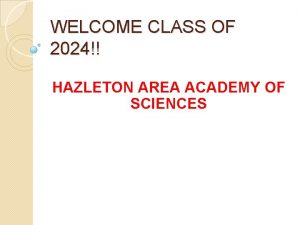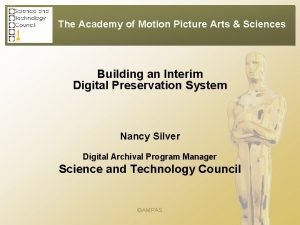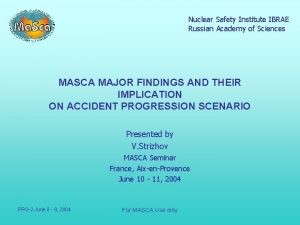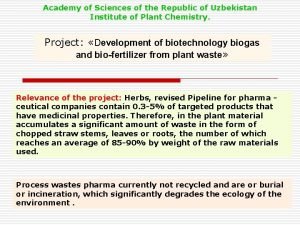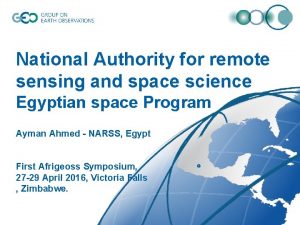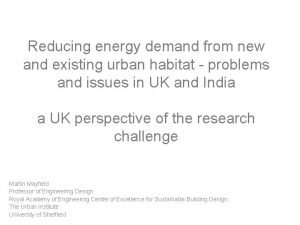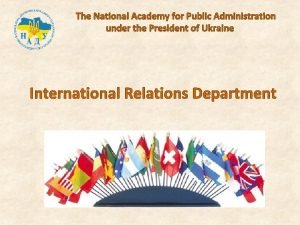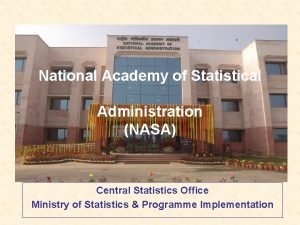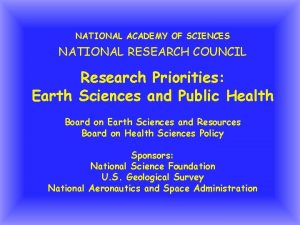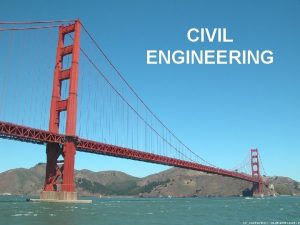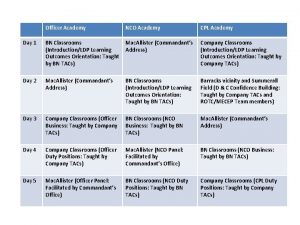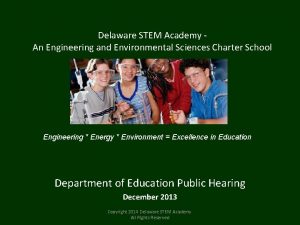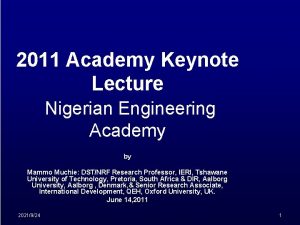National Academy of Sciences National Academy of Engineering

































- Slides: 33

National Academy of Sciences National Academy of Engineering Institute of Medicine National Research Council A presentation developed by the National Academy of Sciences based on its report Ecological Impacts of Climate Change (2009): www. nas. edu/climatechange.

National Academy of Sciences National Academy of Engineering Institute of Medicine National Research Council The Climate is Changing • • Temperatures are rising Sea levels are rising The ocean is acidifying Climate change is reflected in Temperature rise, indicated by color water cycle changes and in (red=higher rate of increase). Earth’s surface temperature has risen ~1. 3˚ F since 1850. extreme weather Image courtesy of the Joint Institute for the Study of the Atmosphere & Ocean, U. of Washington.

Ecological Impacts National Academy of Sciences National Academy of Engineering Institute of Medicine National Research Council Living things are intimately connected to their physical surroundings. Ecosystems are affected by changes in: – temperature – rainfall/moisture – p. H – salinity (saltiness) – activities & distribution of other species – …many other factors

Ecological Impacts National Academy of Sciences National Academy of Engineering Institute of Medicine National Research Council As a result of climate change, species and ecosystems are experiencing changes in: – – ranges timing of biological activity growth rates relative abundance of species – cycling of water and nutrients – the risk of disturbance from fire, insects, and invasive species

Ecological Impacts National Academy of Sciences National Academy of Engineering Institute of Medicine National Research Council • As a result of climate change, species and ecosystems are experiencing changes in: – – ranges timing of biological activity growth rates relative abundance of species – cycling of water and nutrients – the risk of disturbance from fire, insects, and invasive species

Range Shifts National Academy of Sciences National Academy of Engineering Institute of Medicine National Research Council Species are relocating to areas with more tolerable climate conditions. Range shifts particularly threaten species that: – cannot move fast enough – depend on conditions that are becoming more rare (like sea ice) Plant hardiness zone maps, 1990 and 2006. Most zones shifted northward in this period. Map courtesy of the National Arbor Day Foundation.

Ecological Impacts National Academy of Sciences National Academy of Engineering Institute of Medicine National Research Council As a result of climate change, species and ecosystems are experiencing changes in: – – ranges timing of biological activity growth rates relative abundance of species – cycling of water and nutrients – the risk of disturbance from fire, insects, and invasive species

National Academy of Sciences National Academy of Engineering Institute of Medicine National Research Council Timing of Biological Activity Some seasonal biological activities are happening 15 -20 days earlier than several decades ago: – Trees blooming earlier – Migrating birds arriving earlier – Butterflies emerging earlier Changes in timing differ from species to species, so ecological interactions are disrupted. European pied flycatcher chicks are now born later than the caterpillars they eat. Images used under the terms of the GNU Free Documentation License.

National Academy of Sciences National Academy of Engineering Institute of Medicine National Research Council Global Changes, Local Impacts Although climate change is global, the ecological impacts are often local. What’s happening in your backyard?

National Academy of Sciences National Academy of Engineering Institute of Medicine National Research Council Impacts in the Pacific Coastline Shifting Ranges of Checkerspot Butterflies • Edith’s checkerspot: range has shifted northward and to higher elevations over 40+ years • Quino checkerspot: first endangered species for which climate change is officially listed as a threat and as a factor in the plan for its recovery Image courtesy of Dr. Gordon Pratt, www. quinocheckerspot. com.

National Academy of Sciences National Academy of Engineering Institute of Medicine National Research Council Impacts in the Pacific Coastline Changes in the Water • Shift in species ranges: many species moving northward • Mysterious dead zones along Washington and Oregon coastline: cause undetermined but potential links to climate change Scientists retrieve a water sample for research on a recurring “dead zone” off the coasts of Washington and Oregon. Image courtesy of Oregon State University.

National Academy of Sciences National Academy of Engineering Institute of Medicine National Research Council Impacts in the Pacific Coastline California Wine Industry: Unwelcome Changes? • Climate change affects managed ecosystems like vineyards and farms just as it affects natural ecosystems • Future warming unlikely to help wine growers in California’s premium wine regions: some areas projected to become “marginal” by 2100

National Academy of Sciences National Academy of Engineering Institute of Medicine National Research Council Impacts in Alaska and the Arctic Effects on Ice-Dependent Animals • Year-round sea ice shrinking: walruses and other animals challenged to find platforms for nursing and resting • Polar bears facing difficult hunting conditions: seals now surfacing in open ocean instead of holes in ice

National Academy of Sciences National Academy of Engineering Institute of Medicine National Research Council Impacts in Alaska and the Arctic Changing Food Chains • Increased shrub growth presenting a threat to caribou (wild reindeer) – Shrubs crowding out lichens (a key winter food for caribou) – Shrubs collect snow, causing deep snowdrifts: deep snow makes it hard for caribou to reach lichens hidden beneath

National Academy of Sciences National Academy of Engineering Institute of Medicine National Research Council Impacts in Alaska and the Arctic Feedback Loops: Arctic Warming Faster • The Arctic is warming twice as fast as the rest of the planet – As sea ice and seasonal snow cover melts, previously reflective white surfaces converted to darker surfaces (to ocean water or vegetation) – Thawing permafrost releases carbon dioxide and methane into the atmosphere, increasing greenhouse gases Rate of warming, indicated by colors (red=higher rate). Image created with data from the Goddard Institute for Space Studies.

National Academy of Sciences National Academy of Engineering Institute of Medicine National Research Council Impacts in Western Mountains Wildfire, Drought, and Insects: Complex Interactions Climate change increases the risk of fire in areas where decades of total fire suppression have resulted in buildup of dead fuels. Wildfire increasing in frequency, size, season length: – Longer, more intense summer droughts stressing trees – Stressed trees are more susceptible to attacking beetles, which leave standing dead fuels in their wake A wildfire in Bitterroot National Forest, Montana. Image courtesy of John Mc. Colgan, USDA Forest Service.

National Academy of Sciences National Academy of Engineering Institute of Medicine National Research Council Impacts in Western Mountains Effects on The American Pika • Climbing to higher elevations in response to warming • Many populations now isolated on “mountaintop islands” Pika images courtesy of J. R. Douglass, Yellowstone National Park; Aerial image courtesy NASA.

National Academy of Sciences National Academy of Engineering Institute of Medicine National Research Council Impacts in Western Mountains Changes in Trout Habitat • Earlier springs, warmer summers reducing stream flows as mountain snow melts off earlier in the season • Some streams reaching temperatures lethal to trout (>78˚F) Image courtesy USGS.

National Academy of Sciences National Academy of Engineering Institute of Medicine National Research Council Impacts in Southwestern Deserts Wildfire and Invasive Species • Nonnative grasses becoming established in deserts: – Red brome (in the Mojave) – Buffelgrass (in the Sonoran) • Grasses transform desert into flammable grassland: fire-adapted grasses re-establish quickly, pushing out native species like Saguaro cactus • Spread of grasses not directly a result of climate change, but warming may allow them to further spread in the desert and extend to higher elevations. Image courtesy T. Esque, USGS.

National Academy of Sciences National Academy of Engineering Institute of Medicine National Research Council Impacts in Southwestern Deserts The Piñon Pine: Past a Tipping Point • Drought in 2000 -2003 stressed a large swath of piñons, leaving them susceptible to infestation by pine bark beetles • This example shows how a stressful event can trigger dramatic ecological change when an ecosystem is subject to many interacting stresses 2002 2004 Images courtesy D. Allen, USGS.

National Academy of Sciences National Academy of Engineering Institute of Medicine National Research Council Impacts in the Central U. S. Agricultural Impacts • Difficult to pinpoint climate impacts: climate change occurring along with improvements in farming techniques • In general, plants may: – Grow faster (increasing yields unless it becomes too warm or crops mature too early) – Be affected by carbon dioxide levels (increased growth for some plants, not for others) • Good information about changes and adaptive practices is essential for farmers

National Academy of Sciences National Academy of Engineering Institute of Medicine National Research Council Impacts in the Central U. S. Migratory Waterways: Drying Up? • “Playa lakes” or “Prairie potholes” essential for migrating birds: used for resting, feeding, and mating • Climate change, combined with other pressures (irrigation demands, pollution, etc. ), may dry up these important waterways Image courtesy of the U. S. Fish and Wildlife Service.

National Academy of Sciences National Academy of Engineering Institute of Medicine National Research Council Impacts in the Southeast Challenges to Everglades Restoration Everglades has shrunk due to human manipulation of the region’s water; ongoing efforts aim to restore the ecosystem. • Climate change impacts (increasing water temperature, changes in precipitation) may make restoration efforts more difficult 1850 Today Images courtesy Rodney Cammauf, National Park Service (panther); South Florida Water Management District (maps)

National Academy of Sciences National Academy of Engineering Institute of Medicine National Research Council Impacts in the Southeast Sea-level Rise • Fragments barrier islands, reconfigures shorelines • May leave certain ecosystems struggling to adapt—in particular those adapted to the conditions between land sea • Landward movement of mangroves and marshes may be inhibited by human development

National Academy of Sciences National Academy of Engineering Institute of Medicine National Research Council Impacts in the Southeast Coral Reefs: Multiple Changes • Climate change is compounding other factors affecting reefs (coastal development, pollution, overfishing) • Heat stress causes coral bleaching: corals expel symbiotic algae, leaving white “bones” behind (deadly to coral if long-lasting) • Ocean acidification affects marine organisms’ ability to build shells and skeletons: likely to slow or stop the growth of coral by 2100 Coral bleaching Image courtesy of NOAA.

National Academy of Sciences National Academy of Engineering Institute of Medicine National Research Council Impacts in the Southeast Northward Movement of Tropical Species • Bird and butterfly watchers across the Southeast looking out for new species; some former seasonal migrants now staying year-round The rufous hummingbird has become a yearround resident in Alabama. Image courtesy Dean E. Briggins, U. S. Fish and Wildlife Service.

Impacts in the Northeast Fisheries • Cod: affected by water temperature – Habitat may become restricted to cooler pockets (<54˚F for adults, <46˚F for young) • Lobsters: affected by oxygen levels – Warmer water holds less oxygen: oxygen becomes insufficient for lobsters >79˚F – In north, warming may improve lobster habitat • Oysters: Deadly parasite Perkinsus marinus moving northward – Range expanded from Chesapeake Bay to Maine: shift linked to above-average winter temperatures National Academy of Sciences National Academy of Engineering Institute of Medicine National Research Council

National Academy of Sciences National Academy of Engineering Institute of Medicine National Research Council The Role of Human Beings Causes of Climate Change • It is very likely that most of the climate change in the current era is the result of human activities. – Human activities have increased concentrations of greenhouse gases in the atmosphere. – These gases trap heat and cause the Earth to warm. Figure adapted from Climate Change 2007: The Physical Science Basis. Working Group 1 Contribution to the 4 th Assessment Report of the Intergovernmental Panel on Climate Change. Figure SPM. 5. Cambridge University Press.

National Academy of Sciences National Academy of Engineering Institute of Medicine National Research Council The Role of Human Beings Rate of Climate Change • Climate change in the current era is expected to be extremely rapid compared to transitions in and out of past ice ages. • Ecosystems are more vulnerable to changes that happen rapidly. A scientist holding an ice core—a sample taken from polar ice caps or mountain glaciers. Ice cores reveal clues about climate changes in Earth’s past. Image courtesy USGS National Ice Core Laboratory.

National Academy of Sciences National Academy of Engineering Institute of Medicine National Research Council The Role of Human Beings Compounding Factors • Human activities have many other effects on ecosystems. • These effects compound the effects of climate change, making it more difficult for ecosystems to adapt. – Pollution – Habitat fragmentation – Invasive species – Overfishing – Manipulation of water sources – …and much more

National Academy of Sciences National Academy of Engineering Institute of Medicine National Research Council The Role of Human Beings Improving the Outlook • Changes in activities at the personal, community, and national levels can affect the rate of future climate change and species’ abilities to adapt. • Some of the areas where changes in human activities could help species adapt include: – – – – Approaches to agriculture Water management practices Energy sources and use Transportation Pollution remediation Biological conservation …and much more

National Academy of Sciences National Academy of Engineering Institute of Medicine National Research Council The climate challenge is large and complex. But it is very likely that many people, working from many angles, can help address climate change and its ecological consequences.

Acknowledgments National Academy of Sciences National Academy of Engineering Institute of Medicine National Research Council This presentation was developed by the National Academy of Sciences based on its report, Ecological Impacts of Climate Change (2009). The report, its companion booklet, and this presentation were produced with support from the United States Geological Survey. Ecological Impacts of Climate Change was authored by the following National Research Council committee: CHRISTOPHER B. FIELD, Chair, Carnegie Institution for Science DONALD F. BOESCH, U. of Maryland Center for Environmental Science F. STUART (TERRY) CHAPIN III, University of Alaska PETER H. GLEICK, Pacific Institute ANTHONY C. JANETOS, University of Maryland JANE LUBCHENCO, Oregon State University JONATHAN T. OVERPECK, University of Arizona CAMILLE PARMESAN, University of Texas TERRY L. ROOT, Stanford University STEVEN W. RUNNING, University of Montana STEPHEN H. SCHNEIDER, Stanford University For more information, visit National Research Council Staff ANN REID, Study Director FRANCES E. SHARPLES, Director, Board on Life Sciences ANNE FRANCES JOHNSON, Communications Officer AMANDA CLINE, Senior Program Assistant www. nas. edu/climatechange Unless otherwise noted, all images in this presentation are © Jupiter. Images, 2009. These images were purchased for use in this presentation and may not be reproduced without permission from the owner.
 Railroad training school
Railroad training school National academy of sciences forensic science
National academy of sciences forensic science Natural sciences tok
Natural sciences tok Hazleton area academy of sciences
Hazleton area academy of sciences Academy of motion picture arts and sciences benefits
Academy of motion picture arts and sciences benefits Hawaii academy of arts and sciences
Hawaii academy of arts and sciences Putnam academy
Putnam academy Nuclear safety institute of the russian academy of sciences
Nuclear safety institute of the russian academy of sciences Uzbek academy of sciences
Uzbek academy of sciences Comorbidity examples
Comorbidity examples Cleveland arts and social sciences academy
Cleveland arts and social sciences academy National authority for remote sensing and space sciences
National authority for remote sensing and space sciences Institut national des sciences appliquées founded
Institut national des sciences appliquées founded National center for theoretical sciences
National center for theoretical sciences Mongolian national university of medical sciences
Mongolian national university of medical sciences Royal academy of engineering
Royal academy of engineering John jay science and engineering academy
John jay science and engineering academy Nigerian academy of engineering
Nigerian academy of engineering Engineering ethics in practice a guide for engineers
Engineering ethics in practice a guide for engineers What is system in software engineering
What is system in software engineering Forward engineering and reverse engineering
Forward engineering and reverse engineering Principles of complex systems for systems engineering
Principles of complex systems for systems engineering Elegant systems
Elegant systems Reverse engineering vs forward engineering
Reverse engineering vs forward engineering National academy for public administration
National academy for public administration National academy of statistical administration
National academy of statistical administration National emergency services academy
National emergency services academy National coalition academy
National coalition academy National skills academy for retail
National skills academy for retail Lal bahadur shastri national academy of administration
Lal bahadur shastri national academy of administration National 5 engineering science
National 5 engineering science Ntu ce
Ntu ce Writing papers in the biological sciences
Writing papers in the biological sciences Van hall larenstein university of applied sciences
Van hall larenstein university of applied sciences



